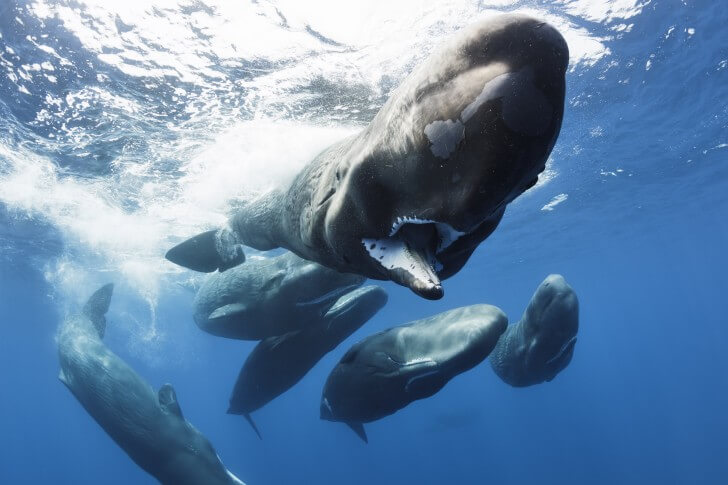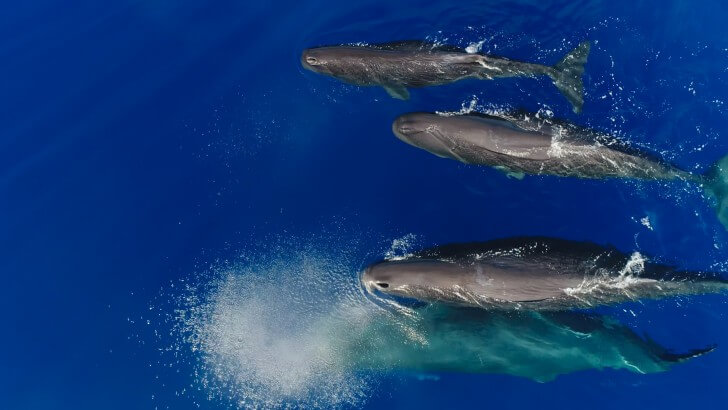BBC Earth newsletter
BBC Earth delivered direct to your inbox
Sign up to receive news, updates and exclusives from BBC Earth and related content from BBC Studios by email.
Blue Planet
Footage gathered using on-animal cameras has allowed a rare view of the sperm whale’s world, and given scientists and viewers an intimate look into sperm whales families.
Sperm whales are icons of the deep, but despite their gigantic size and dramatic stature, their open ocean home is still mostly a mystery. Living together as a family, they can be found throughout the open ocean, spending time in the deep to find food, which makes it a challenge for scientists to document their behaviour. When the Blue Planet II team set out to try and capture this secret world, they enlisted the help of Marine Biologist Dr Shane Gero, who has been studying sperm whales for over 15 years.
“Through thousands of hours in the company of sperm whales, our study has been the first to follow their families across years” says Gero. “We have come to know them as individuals, as brothers and sisters, mothers and babysitters, as experienced grandmothers and babbling babies; and as a multicultural community of neighbouring families. They live rich complex lives that are surprising similar to ours, in part of the world we find difficult to even explore”.

Off the coast of the island of Dominica, Dr Gero attached the Blue Planet team’s new remote camera tags to a sperm whale (Physeter macrocephalus). Like all families it takes a while to get to know them, and he’s been working with for years to try and discover more about their behaviour and interactions within their family unit.
Until now, scientific tags have been fitted to the whales mostly to monitor their sound and movement, creating a three-dimensional model of their underwater world, but new camera technology is allowing us to immerse ourselves in the depths of the ocean as sperm whales embark on their deep-sea hunt. Dives can be to depths over a kilometre as they hold their breath for over an hour.
They live rich complex lives that are surprising similar to ours, in part of the world we find difficult to even explore”.
Attached to a whale the cameras can also clearly pick up sound and the clicks of the sperm whales as they dive. Now, we’re able to accompany the family on their search for food after the light fades and we can no longer see the whales, at which point they rely on sonar to hunt and capture their prey: squid. Filming with the sperm whale family in this way allowed the team to gain an insight into the family group, and to better understand the dynamic between a mother and calf. Gero recalls watching back the footage:
“Actually seeing Digit, the young calf, glide alongside her mother, Fingers, and often touching her as she went down was remarkable. At one-point Digit looked right into the lens of the camera, realised something was on her mom, and reached out to touch the camera, in doing so, she inadvertently adjusted the angle, framing up a better shot than was originally established when I tagged her”.

Young sperm whales typically only accompany their mothers on their hunt until they reach a depth of around 300 metres. At this depth, the calf heads back to the surface and will often be left alone and somewhat vulnerable at the surface for over an hour. In some parts of the world, and in larger pods, they might be babysat by another female in their family, who will take her turn to feed when the rest of the group returns.
“It’s always exciting to get the tags back, because they are full of new information about what life is like in the deep ocean” says Gero. “It’s a part of the world that we don’t often see. This new technology is doing something we can’t, its diving down with the whales and allowing us to see what a whale sees. We’ve never before had this perspective on sperm whale life!”
The technical challenge of constructing a camera that could operate at such depth and under extreme pressure was a feat in itself. Producer John Ruthven worked with a company called CATS and Jonathan Watts of British Technical Films to design and build the cameras. Even so, ‘the devil is in the detail’ to get these cameras to succeed and Ruthven had to work through the night and sometimes bring the units to breakfast while doing final tweaks for the day’s deployments!

With technology developing and opening up new opportunities for study, what is Gero most excited about within the field of sperm whale communication?
“Our study has been unique in that we have been really successful in figuring out ‘Who’ said ‘What’. What calls each of the whales in a family are using. With the tags, we have gained an understanding of ‘Where’ in the water the whales are and ‘When’ the talk to each other. This has allowed us to start asking the big question, ‘Why?’ Why are they talking to each other? What are the meanings of these sounds?”
“Sperm whales appear to use sound to identify themselves, their family, and their ‘cultural clans’. Our new research is asking the whales how they recognize each other, by playing whale calls back to them and recording how they respond on the tags. Their social identity, who they are, is really important to them, just as it is to us. Where I come from defines who I become, and who I am defines so much of what I do; and different communities of whales do things differently, they have different cultures. Unfortunately, the Eastern Caribbean Clan (all the whales that speak a certain local dialect) is at risk. One in three babies will not survive until their first birthday. This decline has made we wonder, what happens when they are all gone? What happens when we loose an entire whale culture? When we loose a way of life?”

“Each culture, whale or otherwise, is a set of solutions on how to solve the problems in the environment in which we live. Losing a culture means losing a deep reservoir of how to succeed – all the traditional wisdom of how to survive in their home, among the Caribbean islands.”
“With the loss of a culture, the species as a whole loses part of its repertoire of how to survive. This is why species conservation must be about more than just global population numbers, we must protect cultures. If we are to preserve life, ours and theirs, we must find ways to succeed together. We must find ways to coexist above and below the surface and value cultural diversity in our societies and in our ecosystems.”
For more incredible ocean stories, follow @OurBluePlanet on Twitter. Get in touch to share your most magical ocean moments with #OurBluePlanet.
#OurBluePlanet is a collaboration between BBC Earth and Alucia Productions.